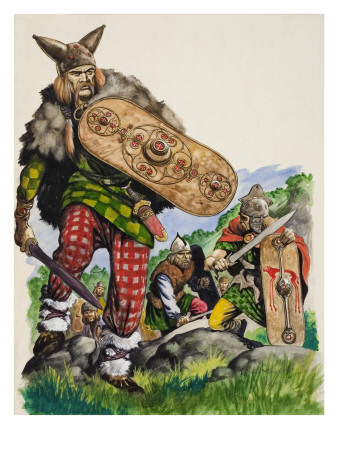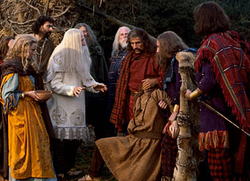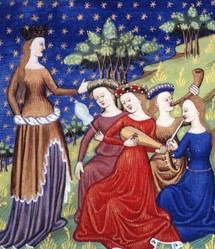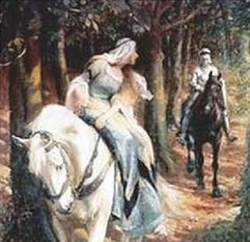Author: Aneirin, aka Neirin or incorrectly Aneurin, a Cumbric bard. He was attached to the Celtic chieftain Urien, who ruled in Rheged (now Cumbria).
Where: Somewhere in Y Hen Ogledd (The Old North). These were once the most northern lands occupied by the Brythonic Celts, until the Angles over-ran it. Parts of Yorkshire, Durham, Tyne and Wear, Northumbria and Cumbria in England, plus the Lowlands of Scotland, collectively make up the geographical region of Y Hen Ogledd.
Cases have been made for Dumbarton (Scotland), or West Yorkshire (England) as being Aneirin's homeland.
Din Eidyn, mentioned in the poem, is almost certainly Edinburgh.
Story told: The bard was an eye-witness at the catastrophic Battle of Catraeth, emerging as just one of four survivors. He penned Y Goddodin as a series of interlinked elegies, telling the story of the battle through those who died in it.
Aneirin does not claim that Arthur was there. He's mentioned as a comparison for another man, Gwawrddur. The 99th stanza ends with the lines:
He fed black ravens on the rampart of a fortress
Though he was no Arthur.
Among the powerful ones in battle
In the front rank, Gwawrddur was a palisade.
Possible agenda: The mention of Arthur is blatantly a cultural reference, which Aneirin expected his audience to understand. It helped them to quickly grasp a sense of what Gwawrddur was like as a warrior and a man; a short-hand code, conveying volumes, without the bard needing to spell it out.
Like me saying, "The boxer was no Mike Tyson, but he was handy with his fists."
The familiar name also lent a veneer of sympathy for the strange warrior. They might not know Gwawrddur, but they knew Arthur, and the warrior was like him. Their feelings could be transferred.
Aneirin proved himself a master of this story-telling device by taking it a stage further. 'Gwawrddur was an Arthur' would have worked as an emotive analogy, but it becomes much more beguiling to say 'Gwawrddur was no Arthur'. Now the warrior seems flawed and human, just like us, but why was he 'no Arthur'? Our imaginations work to fill in the details, guessing at the gap, fixing an ever more vivid impression of Gwawrddur in our heads.
Which all serves to make his loss on the battlefield instantly more tragic. The bard made us care about the unknown soldier.
Finally, Aneirin's agenda - in referencing Arthur - could be nothing more complicated than formatting. In the 6th century, Celts heard their stories, legends, histories and poems through the medium of their bardic oral tradition. It's not obvious in English translations, but the lines of each Y Goddodin stanza end in rhymes. That grouping served as a mnemonic for the bards reciting it.
Gocharai brain du ar fur caer
Cyn ni bai ef Arthur.
Rhwng cyfnerthi yng nghlysur,
Yng nghynnor, gwernor Gwawrddur.
In the Welsh alphabet, 'dd' is the equivalent sound for 'th'. Gwawrddur may have been selected for the analogy simply because his name rhymes with Arthur.
Addition to the Arthurian legend: Arthur had become the benchmark for steadfast bravery, against which all Celtic warriors might now be compared.
Plus he was famous enough for his name to be used as an analogy, in the full expectation that all audiences would have a frame of reference. This can only mean that he was a) a Celtic deity; b) a popular hero from legend; or c) an extremely famous historical or contemporary individual.






























 St Tydecho's Churches in West Waleson 09/03/2014
St Tydecho's Churches in West Waleson 09/03/2014
 Goodies for an Outlander Premiere Partyon 03/06/2015
Goodies for an Outlander Premiere Partyon 03/06/2015
 Holocaust Memorial Day Interview with Rainer Höss, Grandson of Rudolf Architect of Auschwitzon 01/24/2015
Holocaust Memorial Day Interview with Rainer Höss, Grandson of Rudolf Architect of Auschwitzon 01/24/2015
 Romantic Valentine Gifts for an Outlander Fanon 01/16/2015
Romantic Valentine Gifts for an Outlander Fanon 01/16/2015



Comments
Make a list of the places that you want to see. All can happen, with absolute pleasure, if it's involving Wales.
You're very welcome, and thanks for seeing here reading them all for the past hour or so!
Oooh. This sort of brought me back to the first Aurthur article I read, before I got all stressed out from work and then caught up in moving. (I have pt 5 of Maelgwn left to read too, but I'll have to come back to it tomorrow because I'm getting tired). The two of these had me wanting to see so many places you were describing, and I think these were some of the things that had me most excited about coming at first. I can't believe how much just slipped from my mind. I'm going to have to go back through them all now. It'll be a nice way to start to relax again after these hectic past two months... I'm excited! Thanks for writing these :D xD
Now you've alerted me to the possibilities, I'm almost certain there would be. The Arthurian legend isn't merely British. It spread across Europe, then the world by the 12th century. Catholicism was certainly a massive force in the 12th century!
The Vatican library and archives go back centuries, and have been kept carefully. However, I cannot vouch for the condition of the older ones. Whether older ones have crumbled depends upon whether they are parchment or vellum. I am pretty certain that correspondence from ancient rulers will be in the archive, but there is no certainty in this matter. There is also the problem that the archive has not been fully classified up to modern standards, as it is massive.
What might be the case is that there could be the occasional reference in a document. We got that for Robin Hood [Robhod of Wakefield, 1225.] It might be so with Arthur.
Now THAT is a fascinating prospect, which had never actually occurred to me. Do you think there really could be documents in the Vatican which mention Arthur? They would have been safe from so many purges there. But if they weren't being copied every few centuries, wouldn't they have crumbled by now?
This article is so informative that I am going to read over it to extract maximum information.
One interesting point,which you mention, is that Gildas, oddly, does not mention who led the Britons at Mons Badonicus. You would normally mention the winning general, unless you hated his guts. Then you have to mention the battle, but you overlook the winner. Whom did Gildas hate? Arthur. We cannot deduce this conclusion with certainty, but we can infer with degrees of possibility.
I have a dream that one day in a peat bog in Ireland a mass of documents will turn up. Peat preserves and it is possible that monks, under threat from Vikings, rescued and hid some documents that were never recovered, documents that reveal something about Arthur, and other matters as well. Hope springs eternal! Another place to look is the Vatican library and archives, not all of which have been catalogued properly. any reputable historian may use them. All you need is a valid purpose and a letter of support from a reputable academic institution or a bishop. Be assured, your Wiccan faith would be no barrier to using the library, but you would have to have the language to read the documents.